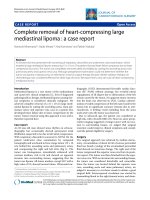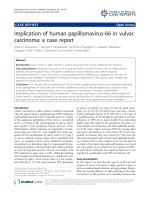Báo cáo y học: "Lung cancer metastasis to the scapula and spine: a case report" pot
Bạn đang xem bản rút gọn của tài liệu. Xem và tải ngay bản đầy đủ của tài liệu tại đây (487.61 KB, 6 trang )
BioMed Central
Page 1 of 6
(page number not for citation purposes)
Chiropractic & Osteopathy
Open Access
Case report
Lung cancer metastasis to the scapula and spine: a case report
James Demetrious*
1,2
and Gregory J Demetrious
3
Address:
1
Private practice, Wilmington, NC, USA,
2
Post-graduate faculty, New York Chiropractic College, Seneca Falls, NY, USA and
3
Private
practice, Wilmington, NC, USA
Email: James Demetrious* - ; Gregory J Demetrious -
* Corresponding author
Abstract
Background: The objective of this case report is to describe the clinical presentation of a patient
who complained of shoulder pain and was diagnosed with carcinoma of the scapula and spine that
metastasized from the lung.
Case presentation: A 76-year-old man without a history of cancer sought chiropractic care for
right shoulder pain. Careful evaluation, radiographs, and subsequent imaging revealed primary and
metastatic lung cancer. The patient was referred to his primary care physician for immediate
medical care. Diagnostic images are included in this case to provide a comprehensive depiction of
the scope of the patient's disease.
Conclusion: Musculoskeletal symptoms are commonly encountered in chiropractic practice. It is
important to recognize that primary lung cancer may be unidentified, and musculoskeletal
symptoms may reflect the first sign of primary or metastatic pulmonary disease. Thoughtful
evaluative procedure and clinical decision making, combined with the use of appropriate diagnostic
tests may allow timely identification of primary or metastatic disease.
Background
In the USA, more people die from lung cancer than any
other type of cancer [1]. This is true for both men and
women. In 2004, lung cancer accounted for more deaths
than breast cancer, prostate cancer, and colon cancer com-
bined [2].
Lung cancer can metastasize to virtually any bone, although
the axial skeleton and proximal long bones are most com-
monly involved [3]. The primary symptom resulting from
bone involvement is pain, which may have a pleuritic com-
ponent when the ribs are involved. Bone pain is present in
up to 25% of all patients at presentation [3].
Patients commonly seek chiropractic care with muscu-
loskeletal complaints [4,5]. Through history and exami-
nation, chiropractic physicians have an opportunity to
assess patients and determine whether serious conditions
are present that may necessitate medical referrals.
Patients with previously identified or yet to be identified
cancer may seek care with chiropractic physicians. This
case report demonstrates previously undiagnosed lung
cancer with widespread metastatic foci.
Case presentation
Case report
A 76-year-old male sought chiropractic care for com-
plaints of right shoulder pain and mild right arm weak-
ness. The onset of pain was insidious and of one week's
duration. Pain was rated 8/10 on a visual analogue scale
(0 = no pain, 10 = the worst pain of one's life). The pain
Published: 12 August 2008
Chiropractic & Osteopathy 2008, 16:8 doi:10.1186/1746-1340-16-8
Received: 29 June 2008
Accepted: 12 August 2008
This article is available from: />© 2008 Demetrious and Demetrious; licensee BioMed Central Ltd.
This is an Open Access article distributed under the terms of the Creative Commons Attribution License ( />),
which permits unrestricted use, distribution, and reproduction in any medium, provided the original work is properly cited.
Chiropractic & Osteopathy 2008, 16:8 />Page 2 of 6
(page number not for citation purposes)
was described as severe and worsened with movement.
Additional symptoms included mild shortness of breath
and posterior thoracic pain on respiration.
The patient's past medical history included headache,
degenerative joint disease affecting the cervical spine, and
a benign thyroid nodule. The patient reportedly smoked
tobacco products for 50 years. He was a retired electrician.
The patient was afebrile. Vital signs were normal. Respira-
tions were 18 cycles per minute. The lungs were clear to
auscultation. The patient reported upper thoracic pain on
inspiration.
A non-tender, mild decrease in active range of motion of
the cervical spine was noted in all planes. No tenderness
was elicited on palpation of the cervical spine. Cervical
compression and Soto-Hall tests were negative. Valsalva
maneuver was negative. Neurologic examination revealed
no focal deficits.
Examination of the right shoulder revealed exquisite ten-
derness on palpation of the lateral border of the scapula
with muscle spasm affecting the ipsilateral infraspinatus,
teres major, and teres minor muscles. Active ranges of
shoulder motion were restricted and painful in abduction,
internal, and external rotation.
Plain film radiographs of the right shoulder (AP with
internal and external rotation views) and thoracic spine
(AP and lateral views) were performed. Disruption of the
cortical margin of the lateral border of the right scapula
was noted as evidenced by an indistinct lucency (see Fig-
ure 1). In addition, a suspicious mass was noted in the
hilar region of the right lung. Complete loss of the right
hilar vascular detail secondary to the tumor mass effect
were noted with visualized subsegmental infiltrate densi-
ties. No evidence of pleural effusion was noted.
The initial diagnostic impression included: suspicious
right lung pathology and apparent lytic process affecting
the scapula of an unknown origin. The patient was
referred for imaging evaluations that included chest x-ray
(CXR) and computed tomographic (CT) evaluation of the
chest. He was referred to his primary care medical physi-
cian.
The CXR and CT examination of the chest, abdomen and
pelvis revealed:
1. A large mass in the right upper lobe of the lung with
associated mediastinal and hilar adenopathy (see Figures
2 and 3).
2. Metastatic disease of the scapula (see Figure 4).
3. Metastatic liver disease.
Subsequent bone scintigraphy revealed abnormal
increased accumulation of radiopharmaceutical along the
lateral aspect of the right scapula (see Figure 5). MRI eval-
uation revealed additional metastatic foci including the
cervical, thoracic and lumbar spinal regions as evidenced
by multiple regions of decreased signal intensity are visu-
alized on T1 weighted images (see Figures 6 and 7).
AP radiograph of the right scapula reveals a focal indistinct lucency and lytic destruction of the lateral scapular cortical marginFigure 1
AP radiograph of the right scapula reveals a focal
indistinct lucency and lytic destruction of the lateral
scapular cortical margin.
PA chest radiograph reveals a right hilar massFigure 2
PA chest radiograph reveals a right hilar mass.
Chiropractic & Osteopathy 2008, 16:8 />Page 3 of 6
(page number not for citation purposes)
Biopsy confirmed a primary lung carcinoma origin.
Unfortunately, the patient succumbed to the disease
within 3 months of its diagnosis.
Discussion
Chiropractic considerations
The identification of primary or secondary metastatic can-
cer requires careful consideration with regard to history
and physical examination. A key objective for the chiro-
practic physician is to identify "red flags" as quickly as
possible. This is especially true for any disease process that
may weaken bone.
The application of directed force into spinal or osseous
structures inherent to the chiropractic adjustment man-
date careful evaluative procedure. Janse defined the
adjustment as a specific form of articular manipulation
using long or short lever techniques with specific contacts
and is characterized by a dynamic thrust of controlled
velocity, amplitude and direction [6].
While chiropractic physicians are challenged with the
responsibility of attempting to identify relative and abso-
lute contraindications to spinal adjustments, sometimes
early onset, insidious and seemingly innocuous symp-
toms may delay early identification [7,8].
Clinical considerations
When primary cancer is not yet identified, metastatic
extension to skeletal structures can at times be difficult to
detect [7,8]. As was illustrated in this case, clinical consid-
erations that may assist or delay the identification of met-
astatic bone disease include:
1. Early in the course of the disease progression, impor-
tant red flag identifiers may not initially be present and
can delay early identification.
2. Initial pain presentations may be suggestive of com-
mon clinical conditions that are less aggressive.
3. Patients may or not be aware of, or report, the existence
of a primary cancer.
4. Pain can be initially mild to severe and is often progres-
sive in nature and unremitting despite therapeutic inter-
ventions.
5. It is sometimes extremely difficult to positively identify
metastatic disease due to complex clinical factors [7,8].
Red flag indicators for metastatic bone disease include:
age over 50 or under 20 years, a history of cancer, consti-
tutional symptoms including unexplained weight loss,
CT of the chest reveals a large mass in the right upper lobe of the lung with associated mediastinal and hilar adenopathyFigure 3
CT of the chest reveals a large mass in the right
upper lobe of the lung with associated mediastinal
and hilar adenopathy.
CT of the chest reveals cortical lucency, expansile destruc-tion, and medullary invasion due to metastatic lung carci-noma affecting the right scapulaFigure 4
CT of the chest reveals cortical lucency, expansile
destruction, and medullary invasion due to meta-
static lung carcinoma affecting the right scapula.
Chiropractic & Osteopathy 2008, 16:8 />Page 4 of 6
(page number not for citation purposes)
pain worse at night or in atypical areas, no significant
improvement after > 1 month of conservative (non-inva-
sive) care, pain that has no mechanical exacerbating or
remitting factors, and severe disabling pain affecting a
child or adolescent [9].
Diagnostic imaging considerations
Humphrey reported that about 25% of people with lung
cancer do not have symptoms from advanced cancer
when their lung cancer is found [10]. Maghfoor reported
that 7–10% of patients with lung cancer are asymptomatic
and their cancers are diagnosed incidentally after a CXR
was performed for other reasons [11]. Numerous studies
have shown that the chest radiograph lacks sensitivity in
detecting mediastinal lymph node metastases and in
detecting chest wall and mediastinal invasion [12].
CT has become the major imaging modality of choice in
the evaluation of patients with bronchogenic carcinoma
[13]. Traditionally, chest CT for staging of lung cancer is
extended into the abdomen to include the adrenal glands.
Whether this requires intravenous contrast material is
debatable [13]. Patz et al. [14] concluded that contrast-
enhanced CT extended to include the liver rarely adds to
Bone scintigraphy of the right scapula reveals increased uptake where metastatic lung carcinoma is presentFigure 5
Bone scintigraphy of the right scapula reveals
increased uptake where metastatic lung carcinoma is
present.
MRI sagittal T1WI reveals scattered foci of decreased signal intensity reflective of metastatic disease affecting the cervical and thoracic spine regionsFigure 6
MRI sagittal T1WI reveals scattered foci of
decreased signal intensity reflective of metastatic dis-
ease affecting the cervical and thoracic spine regions.
MRI sagittal T1WI reveals scattered foci of decreased signal intensity reflective of metastatic disease affecting the tho-raco-lumbar spineFigure 7
MRI sagittal T1WI reveals scattered foci of
decreased signal intensity reflective of metastatic dis-
ease affecting the thoraco-lumbar spine.
Chiropractic & Osteopathy 2008, 16:8 />Page 5 of 6
(page number not for citation purposes)
routine nonenhanced CT through the adrenal glands and
does not influence management decisions.
The evaluation of the mediastinum with magnetic reso-
nance imaging (MRI) is approximately equal to that of CT
with regard to the staging of bronchogenic carcinoma and
MRI is significantly more accurate for detecting direct
mediastinal invasion [15]. Other studies have confirmed
the usefulness of MRI, particularly in the evaluation of
chest wall invasion and the local staging of superior sulcus
tumors [16,17]. The general conclusion of these studies is
that MRI has advantages in the assessment of both chest
wall and mediastinal invasion [13].
Indications for the use of whole body positron emission
tomography imaging in lung cancer using 18-fluorodeox-
yglucose (FDG-PET) in patients with non-small cell lung
cancer include high clinical index of suspicion of high
grade malignancy and radiographic evidence of nodal
enlargement [13]. In addition, PET scans may be helpful
in centers where mediastinoscopy is not readily available
and in patients with significant comorbid conditions who
are borderline candidates for surgery, with locally
advanced disease, solitary brain metastasis, and cases of
local recurrence that might qualify for reoperation
[18,19].
Bone scintigraphy in the detection of metastatic disease
has significant limitations. Although it has high sensitiv-
ity, it is noted for having very low specificity that ranges
from 50%–60% [13]. Bone scintigraphy should probably
be limited to cases in which patients have specified clini-
cal indicators of bone metastasis [20].
When evaluating suspected pulmonary metastasis, CXR
and CT of the chest are rated by the American College of
Radiology (ACR) scale as: "9 – most appropriate" (Rating
Scale: 1-Least appropriate, 9-Most appropriate) [21]. It is
generally accepted that chest radiography, with poster-
oanterior (PA) and lateral views, should be the initial
imaging test in patients without known or suspected tho-
racic metastatic disease [22-24]. Compared with chest
radiography, CT is much more sensitive for detecting pul-
monary nodules, because of its lack of superimposition
and its high contrast resolution [22-24].
Conclusion
Lung cancer is a significant and aggressive primary cancer
with a predilection for skeletal metastasis. When primary
lung cancer is not previously identified, metastatic disease
to skeletal structures may initially manifest as muscu-
loskeletal complaints. Careful diagnostic evaluation and
decision making may allow for earlier diagnosis.
Competing interests
The authors declare that they have no competing interests.
Authors' contributions
JD conceived the study and drafted the manuscript. GJD
participated in the care of the patient and provided data
related to the case. Both authors read and approved the
final manuscript.
Acknowledgements
Written informed consent was obtained from the decedent's wife for pub-
lication of this case report and accompanying images. A copy of the written
consent is available for review by the Editor-in-Chief of this journal.
The authors wish to thank Anthony V. D'Antoni, DC, MS, PhD(c) and Ste-
ven Yeomans, DC, FACO for their thorough editorial assistance.
References
1. American Cancer Society: Cancer Facts and Figures. Atlanta 2007.
2. U.S. Cancer Statistics Working Group: United States Cancer Statistics:
2004 Incidence and Mortality Atlanta (GA): Department of Health and
Human Services, Centers for Disease Control and Prevention, and
National Cancer Institute; 2007.
3. Beckles MA, Spiro SG, Colice GL, Rudd RM: Initial evaluation of
the patient with lung cancer – symptoms, signs, laboratory
tests, and paraneoplastic syndromes. Chest 2003,
123:97S-104S.
4. Manga P: Economic case for the integration of chiropractic
services into the health care system. Journal of Manipulative &
Physiological Therapeutics 2000, 23(2):118-22.
5. Dagenais S, Haldeman S: Chiropractic. Clinics in Office Practice 2002,
29(2):419-37.
6. Haldeman S: Appendix B – Chiropractic glossary of commonly
used terms. In Prinicples and Practice of Chiropractic 2nd edition.
Edited by: Haldeman S. Connecticut: Appleton & Lange;
1992:621-628.
7. Demetrious J: Metastatic testicular seminoma of the cervicot-
horacic spine. J Manipulative Physiol Ther 1992, 15(8):525-528.
8. Demetrious J: Renal cell carcinoma of the sternum and spine
that mimicked costochondritis. Journal of the Neuromusculoskele-
tal System 1995, 3(1):16-19.
9. Murphy DR, Letz G, Morris CE: Red flags for serious disease in
low back syndromes. In Low Back Syndromes: Integrated Clinical
Management Edited by: Morris CE. United States of America:
McGraw-Hill; 2006:277-286.
10. Humphrey LL, Teutsch S, Johnson MS: Lung cancer screening
with sputum cytologic examination, chest radiography, and
computed tomography: an update for the US Preventive
Services Task Force. Annals of Internal Medicine 2004,
140:740-753.
11. Lung Cancer, Non-Small Cell. Maghfoor I [d
icine.com/med/topic1333.htm]. Accessed June 21, 2008
12. Bragg DG: The diagnosis in staging of primary lung cancer.
Radiol Clin North Am 1994, 32(1):1-14.
13. American College of Radiology: ACR Appropriateness Criteria® screen-
ing for staging of bronchogenic carcinoma. Virginia; 2005.
14. Patz EF Jr, Erasmus JJ, McAdams HP, Connolly JE, Marom EM, Good-
man PC, Leder RA, Keogan MT, Herndon JE: Lung cancer staging
and management: comparison of contrast-enhanced and
nonenhanced helical CT of the thorax. Radiology 1999,
212(1):56-60.
15. Webb WR, Gatsonis C, Zerhouni EA, Heelan RT, Glazer GM, Francis
IR, McNeil BJ: CT and MR imaging in staging non-small cell
bronchogenic carcinoma: report of the Radiologic Diagnos-
tic Oncology Group. Radiology 1991, 178(3):705-713.
16. Heelan RT, Demas BE, Caravelli JF, Martini N, Bains MS, McCormack
PM, Burt M, Panicek DM, Mitzner A: Superior sulcus tumors: CT
and MR imaging. Radiology 1989, 170(3 Pt 1):637-641.
17. Padovani B, Mouroux J, Seksik L, Chanalet S, Sedat J, Rotomondo C,
Richelme H, Serres JJ: Chest wall invasion by bronchogenic car-
Publish with BioMed Central and every
scientist can read your work free of charge
"BioMed Central will be the most significant development for
disseminating the results of biomedical research in our lifetime."
Sir Paul Nurse, Cancer Research UK
Your research papers will be:
available free of charge to the entire biomedical community
peer reviewed and published immediately upon acceptance
cited in PubMed and archived on PubMed Central
yours — you keep the copyright
Submit your manuscript here:
/>BioMedcentral
Chiropractic & Osteopathy 2008, 16:8 />Page 6 of 6
(page number not for citation purposes)
cinoma: evaluation with MR imaging. Radiology 1993,
187:33-38.
18. Weder W, Schmid RA, Bruchhaus H, Hillinger S, von Schulthess GK,
Steinert HC: Detection of extrathoracic metastases by posi-
tron emission tomography in lung cancer. Ann Thorac Surg
1998, 66(3):886-893.
19. Detterbeck FC, Falen S, Rivera MP, Halle JS, Socinski MA: Seeking a
home for a PET, part 2: Defining the appropriate place for
positron emission tomography imaging in the staging of
patients with suspected lung cancer. Lancet 2004,
125(6):2300-2308.
20. Michel F, Soler M, Imhof E, Perruchoud AP: Initial staging of non-
small cell lung cancer: value of routine radioisotope bone
scanning. Thorax 1991, 46(7):469-473.
21. American College of Radiology: ACR Appropriateness Criteria® Screen-
ing for Pulmonary Metastases Primary malignancy: head and neck carci-
noma. Virginia; 2006.
22. Davis SD: CT evaluation for pulmonary metastases in patients
with extrathoracic malignancy. Radiology 1991, 180(1):1-12.
23. Snyder BJ, Pugatch RD: Imaging characteristics of metastatic
disease to the chest. Chest Surg Clin N Am 1998, 8(1):29-48.
24. Herold CJ, Bankier AA, Fleischmann D: Lung metastases. Eur
Radiol 1996, 6(5):596-606.









